The Ottoman Empire and its naval strategy in the galley era
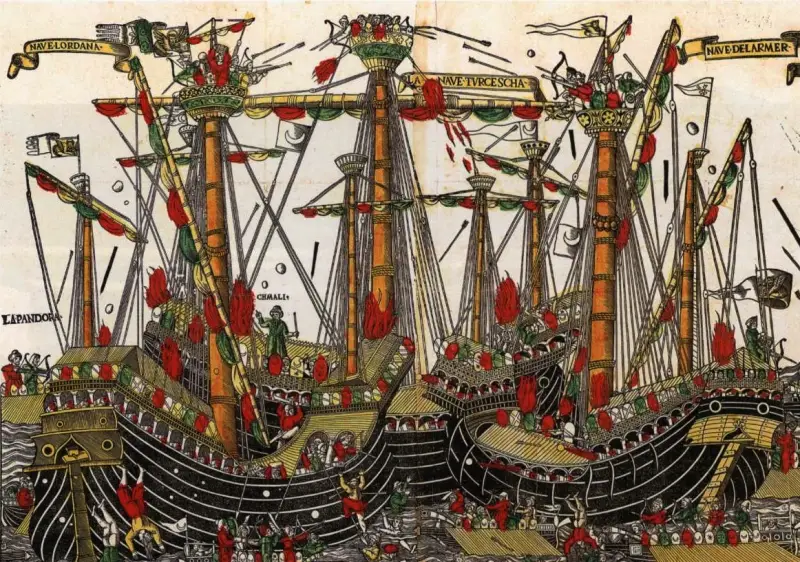
First Battle of Lepanto, 1499.
In 1657, Katib Celebi presented Sultan Mehmed IV with a richly illustrated and decorated book called "Gift to the Great on Naval Campaigns" (Tuhfet ül-kibar fi esfar il-bihar, original spelling – تحفة الكبار في اسفار البحار). IN historical In literature, this book has a firmly established abbreviated title - “Sea Campaigns”. In fact, it was the first historical treatise on the history of the Ottoman fleet.
It must be said that the book described all significant events in the Mediterranean since the 1400s, and became one of the main Turkish sources for any researchers on this period. For example, it was actively used when Roger Charles Anderson wrote his work “Naval Wars in the Levant 1559–1853.”
Celebi in his study not only lists certain events, but also shows why the naval power of the state is needed, long before Alfred Mahan and Philippe Colomb. But at the same time, the main emphasis in the book is on amphibious operations.
In fact, for the period from 1522 to 1620 (that is, from the siege of Rhodes to the raid on the castle of Manfredonia in Italy), coastal fortresses and control over them played a dominant role in the struggle for supremacy at sea.
As John Francis Gilmartin Jr. noted in Gunpowder and Galleys: Changing Technology and Naval Warfare in the 16th-Century Mediterranean,
Roughly speaking, ownership of coastal schwerpunkts was the only way to maintain effective control over certain communications and areas. In that era, ships could not sail on the sea for weeks or months (not to mention years), so in order to concentrate forces and operate in a particular area, they needed jumping bases, where they could receive supplies and provisions, bring themselves to a relative order, wait out the storm or bad weather. Castles and fortresses served as these schwerpunkts, not only protecting their water area at least to the firing range of guns, but also spreading influence deep into the territory, to neighboring cities and settlements.
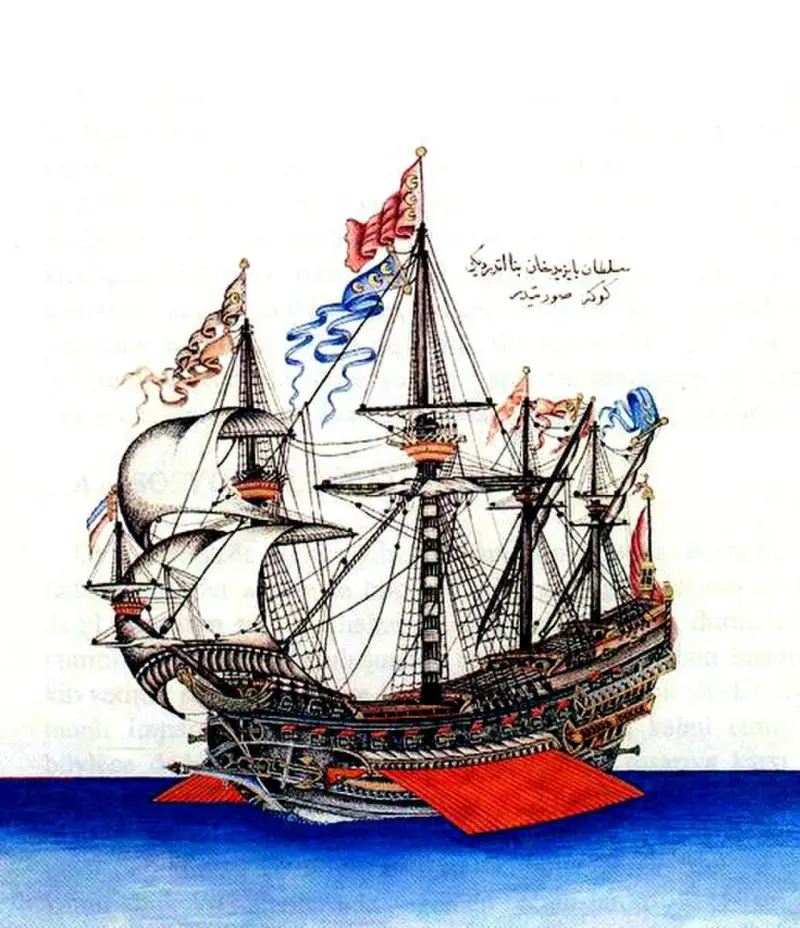
Flagship galley of Kapudan Pasha Kemal Reis.
In fact, starting in the 1500s, the Ottoman fleet began to fight for these coastal fortresses, unleashing a real network of amphibious operations.
Features of the Turkish fleet in the 16th century
In the 1500s, the main combat unit of the Ottoman navy was the galley. Although it was equipped with sails, the main means of transportation for it were oars, and the engine was the muscular power of the rowers. Most often, an Ottoman galley had 35 crew members, 100 soldiers and 200 oarsmen (2 rowers per oar, 25 pairs of oars). A ship of this type measured 26 meters long and 5 meters wide.
It is clear that with such a “population” and size there was very little space for provisions and water, although during cruising, galley commanders could set a rotation schedule for their oarsmen so as not to exhaust them, but even with such an innovation it was not possible to stay at sea for more than a few days . Consequently, it was vitally necessary to be able to replenish provisions and water on land, since already during the siege of Rhodes (1522) it was necessary to operate at a great distance from the home port (Istanbul).
Thus, forward bases in the form of ports, protected by nearby fortresses, were critical to extending the time a fleet could stay closer to a potential point of action. Moreover, the creation of a chain of such bases throughout the Mediterranean allowed the Ottomans to use short-range galleys for expeditions even to Spain.
Technically, the Turks quickly developed a scheme for capturing such fortresses - they were simply attacked simultaneously by both the army from land and the fleet from the sea. Cut off from reinforcements and overwhelmed by numbers, the fortresses quickly surrendered. Thus Lesvos was captured in 1492, Kafa in 1475, and Matrega in 1482.
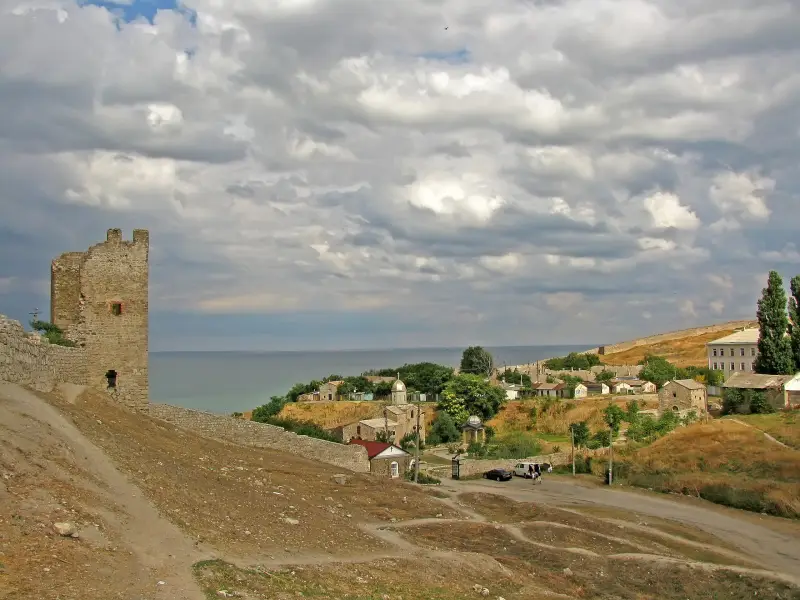
Ruins of the Genoese fortress Kafa (Feodosia).
However, not all sieges went so smoothly.
In 1500, after the first battle of Lepanto (1499), the Ottoman fleet besieged the fortress of Modon (now Methoni) in the Peloponnese. After bombardment from land and sea, the fall of the fortress seemed inevitable when suddenly the Venetian fleet of Marco Gabriel approached Modon, which was carrying reinforcements for the fortress. It is clear that the Ottoman Kapudan Pasha Kemal Reis had to engage in battle with the Venetian fleet. At the same time, the army attacked, and since the castle was partially on fire, the defenders wavered and went to negotiate.
As a result, the Venetian fleet was defeated, Modon Castle was surrendered, and its defenders left the city with personal belongings and weapons.
Corsairs of North Africa
The Barbary pirate states were started by two brothers - Arouj and Khyzyr Barbarossa (as they were later called in Europe because of their red beards). From 1510, both brothers made their main base the island of Djerba, 50 miles off the coast of Tunisia, and began their own gradual conquest of the surrounding area, combining this with privateering against Italy and Spain.
But the corsairs needed a base on the continent like air. And the brothers... bought themselves the first such base. An area not far from Tunisia proper - La Gollette, where the corsairs built a small castle, was given to them by the local dey for... a 20 percent discount on captured goods.
Khyzyr (Khaireddin) Barbarossa on the bow of his galley after the victory at Pereverza, 1538.
Charles V later had to besiege and, with great difficulty, capture this fortress in 1535.
In 1516, the brothers managed to capture two cities on the coast - Gijelli and Algiers, and now these ports became their main bases of operations. Arouj tried to begin expansion into the continent and was killed, and Khizir, left by his brother in charge of Algeria, asked for help from the Sultan, in return offering Selim I “all or most of Barbary.”
Selim took Algeria into his possession as a sanjak (a province with a certain degree of autonomy), appointed Khyzyra as governor, and sent 6 soldiers to strengthen the corsairs. This allowed Khizir to recapture the city of Tlemcen, and turn Algiers into a real fortified naval base. By 000 he was in command of a fleet of 1529 galleys and "had become no less feared and famous than his brother."
Now, having an impregnable base, Khyzyr turned around with might and main. Its captains began a “maritime jihad”, conducting a series of raids on the Balearic Islands, Sardinia, Sicily, Calabria, and Liguria. These raids were so successful that in 1533 the Sultan invited the head of the pirates to Istanbul and appointed him head (kapudan pasha) of the Ottoman fleet, giving him the name Khair ad-Din (“best of the faithful”), and with this slightly altered name ( Hayreddin) he went down in history.
Due to the emergence of the Barbary "Coastal Brotherhood", the Turks received bases that allowed them to operate in the region of Italy, Sicily, Sardinia and even Spain.
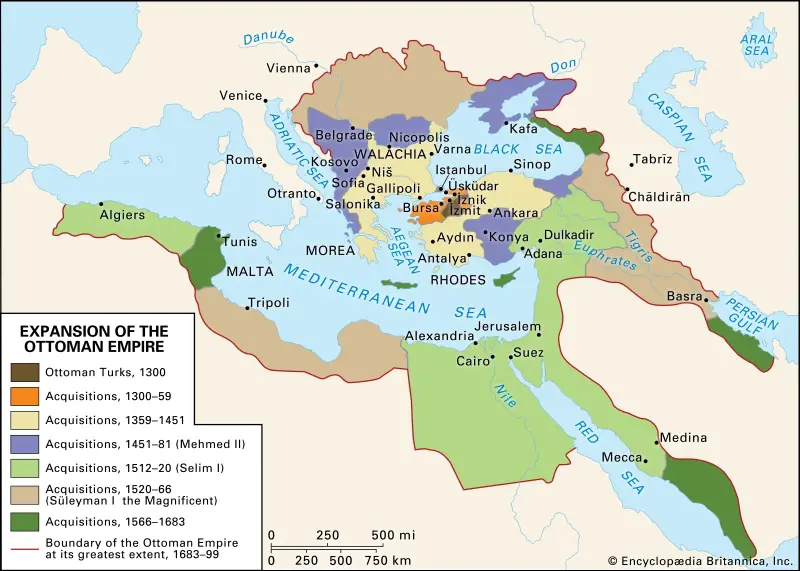
Map of the expansion of the Ottoman Empire in the 14th–16th centuries.
But here a problem arose - the fact is that the Sultan and the corsairs had different views on strategy. As Selim I said to his Kapudan Pasha Piri Reis:
Roughly speaking, this was the first, but far from the last time, when land and sea strategies came together in a clinch.
The Sultan clearly did not understand that the corsairs were looking for points of application of force and control of communications, and that the conquest of the same Malta was seen by the corsairs as much more important than the capture of Illyria or Sicily, simply because, having owned Malta, one could always capture Illyria and dictate his will to Sicily.
Celebi just noted this in his book:
Lepanto
As Celebi writes, excessive control can be just as dangerous as lack of attention. And as an example, he cites the battle of Lepanto (1571). Thus, during discussions of the strategy leading to the Battle of Lepanto, Kapudan Pasha Muezzinzade Ali Pasha decreed: “Wherever the infidel fleet is, attack and fight it; otherwise you will be reprimanded." At the same time, Ali Pasha himself had no maritime practice or experience at all and did not understand that the raiding, amphibious tactics that the Ottomans had used for the last 60 years, in a situation of confrontation with a coalition of Christian states, were much more effective and efficient than the theory of a general battle.
Battle of Lepanto, 1671. Fresco in the Vatican Gallery.
In the end, galleys, unlike later battleships, were not piece goods, but consumables that were quite easy to restore (for example, at Lepanto, the Ottomans had 222 galleys, and the very next year after the defeat they not only restored their numbers , but also surpassed it, bringing 242 galleys to sea). Moreover, the amphibious raids of the Turks forced Venice to make peace with Turkey in 1573.
What was truly negative about the result of the Battle of Lepanto was that the myth of Ottoman invincibility was dispelled. That is, Lepanto was more of a moral victory for Christians.
Celebi says that a peace beneficial to Turkey was concluded even after the defeat of the Ottoman fleet, due to a return to the correct strategy, combining landing operations and simply the existence of a large number of combat units.
Theory of landing operation in Turkish
At one time, Julian Stafford Corbett wrote that the most significant amphibious operations are those where there is close and clear coordination between naval and ground forces. At the same time, Corbett saw three tasks for the fleet in such operations:
B. Protection of landing forces from threats from the sea.
B. Support for the army on the offensive.
How was this implemented in the Ottoman fleet of the 16th century?
Well, firstly, the Ottomans had a large transport fleet, which was primarily engaged in transporting artillery to besieged fortresses.
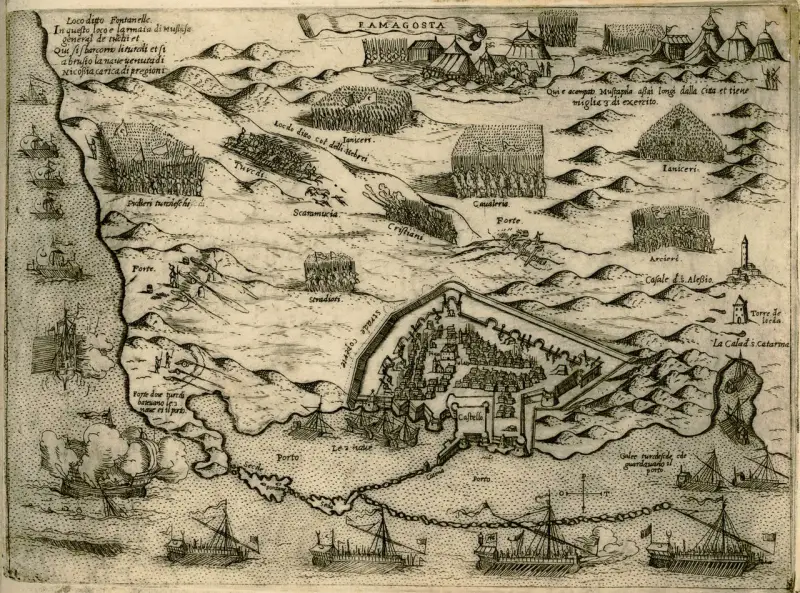
Siege of Famagusta by the Ottomans, 1574.
The fact is that galley guns of that period did not have a significant range for any kind of normal fire support. However, the Ottomans at the first stage could simply remove the cannons from the galleys and sacrifice firepower at sea in favor of firepower on land.
Next, the transport fleet ships came into play, which Celebi calls “gemesi”, “tash gemesi” and “ortyulyu” (gemisi, taş gemisi, örtülü). The first were used for transporting guns, the second - for transporting ammunition, and the third - as gunpowder deliveries.
Both during the siege of Rhodes and the siege of Malta, the Turks transferred large-caliber artillery with the help of the auxiliary fleet.
Thus, to summarize, we can say that the Ottoman fleet of the 16th century was an example of unique naval power, aimed not at pitched battles, but at the war for coastal communications. He chose cruising and landing operations as his main tactics, actively participated in the capture of coastal fortresses, not only covered, but in many ways ensured the success of the army on the coastal flank, and was engaged not only in military operations, but also in supply.
References:
1. Çelebi, Katib “The Gift to the Great Ones on Naval Campaigns” – Edited by Idris Bostan. Ankara: Prime Minister Undersecretariat for Maritime Affairs, 2008.
2. Corbett, Sir Julian S. “Some Principles of Maritime Strategy” - London: Brassey's Defense Publishers, 1988.
3. Guilmartin, John Frances, Jr. "Gunpowder and Galleys: Changing Technology and Mediterranean Warfare at Sea in the 16th Century" - Annapolis: Naval Institute Press, 2003.
4. Brummett, Palmira “Ottoman Seapower and Levantine Diplomacy in the Age of Discovery” - Albany, NY: State University of New York, 1994.
5. Miri Shefer Mossensohn, “Medical Treatment in the Ottoman Navy in the Early Modern Period,” Journal of the Economic and Social History of the Orient, 50, no. 4 (2007), 555–560.
Information